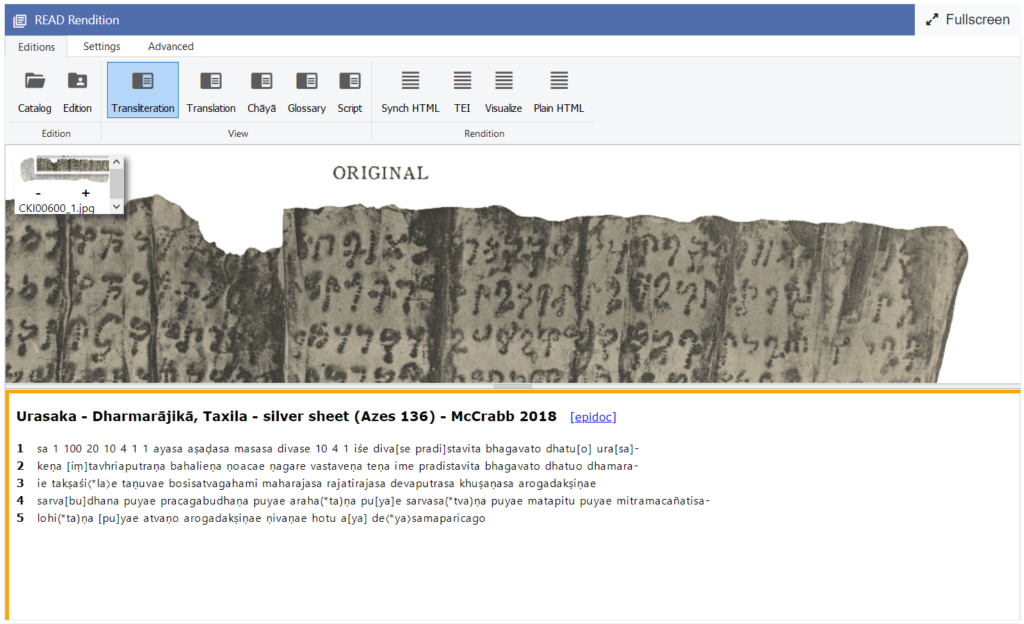This is the first text on scroll 20 of the Robert Senior collection. It is a Buddhist sūtra, or discourse attributed to the Buddha. I have reconstructed the Gāndhārī title *Suhadukha Sutra based on its subject, the cause of pleasure and pain (G. suhadukha). There does not appear to be any complete parallel in other Buddhist languages, but the text’s component parts—a conversation between the Buddha and an unnamed Brahmin, a teaching about the origin of pleasure and pain, and a simile about a gatekeeper in a fortified city—can all be found in similar presentations in other discourses in Pali, Chinese, or Sanskrit. The closest parallels to the Suhadukha Sutra’s component parts can be found in the Pali Saṃyutta-nikāya in the Saḷāyatana-saṃyutta (Chapter on the Six Sense Bases).
Item Robert Senior Scroll 20 | Text 1 | Surface r.1 – r.11 | Material Birch Bark | Size H: 19.7 cm; W: 22.3 cm | Findspot uncertain (presumably Haḍḍa, Afghanistan) | Date approx. 140 CE | Current Location University of Washington, Seattle
Content Summary
An unnamed brahmin asks the Buddha about the cause of pleasure and pain in the world. The Buddha says that contact with the six sense bases (eye, ear, etc.) gives rise internally to pleasure and pain. The Buddha illustrates his teaching with a simile about a gatekeeper in a fortified city with six gates: just as the gatekeeper can infer that anyone who enters or exits the city must use those gates, so too can a person infer that all pleasure and pain arise due to contact with the six sense bases. The brahmin delights in the teaching and takes refuge in the three jewels: the Buddha, dharma, and saṅgha. No setting is provided.
Keywords
city, pain, pleasure, six senses
Parallels
- P. A similar teaching about the arising of pleasure and pain with a different simile is found in Hatthapādupama-suttas 1 and 2 SN 35.195-6 at SN IV 171-2.
- P. Simile of the fortified city in Uttiya-sutta AN V 194-195.
- P. Simile of the fortified city in Mahāparinibbāna-sutta DN 16 at DN II 83.
- P. Simile of the fortified city in Sampasādanīya-sutta DN 28 at DN III 100-101.
- P. Simile of the fortified city in Nālandā-sutta SN 47.12 at SN V 160.
- P. Alternate simile of the fortified city in Kiṃsuka-sutta SN 35.204 at SN IV 194-195.
- Ch. SĀ 1166 at T II 311b26-c8 (= P. Hatthapādupama-sutta)
- Ch. SĀ 965 at T II 248a3-a9 (= P. Uttiya-sutta)
- Ch. SĀ 498 at T II 131a7-a11 (= P. Nālandā-sutta)
- Ch. SĀ 1175 at T II 315b7-316a8 (= P. Kiṃsuka-sutta)
Companion Publications
- Marino, Joseph. 2020. “The Gāndhārī ‘Discourse on Pleasure and Pain’: Some Thoughts on Similes and Textual Variation in the Connected Discourses,” in Dhammadinnā, ed., Research on the Saṃyukta-āgama. Taipei: Dharma Drum Publishing Corporation, 259-300.
Acknowledgements
Research on this edition was completed with the generous support of the Dhammachai International Research Institute and the Robert H. N. Ho Family Foundation in Buddhist Studies.
Digital publishing by Joe Marino and Ian McCrabb
Each digital edition includes background information about the text, a summary of its content, and references to parallel texts and related publications. Users can explore the text, image, and other analysis resources through various preset views from the READ interface, or customize the views themselves.
By developing the text in READ, the text and image are linked such that selecting a syllable, word, or compound in the text or glossary will highlight the associated akṣaras on the manuscript. This allows you to in effect “read” the manuscript as you read the transcribed text, even if you do not know the script.
Users can choose from several preset READ views by selecting the tabs at the top. Each of these convenient arrangements of text and resources is suited to a different experience with the manuscript. For instance, choose the Script view to study the paleography of the manuscript or the Glossary view to study its vocabulary. It is recommended that the user toggles through the default views to gain a holistic perspective of the text.

- Transliteration: Image and transliteration.
- Translation: Transliteration and translation.
- Chāyā: Transliteration and chāyā.
- Glossary: Image, transliteration, and glossary.
- Script: Image, transliteration, and script chart
- Visualize: Visualize the text structure display.
- Synch HTML: Interactive synchronized rendition.
- TEI: EpiDoc TEI rendition.
- Plain HTML: Transliteration in HTML format.
Avś
Be
Ce
Ch.
CPS
DhG
Ee
FJJ
Mahīś
MūSā
Mvu
P
SĀ
SBhV
Se
Skt.
SN
T
Tib.
Vin
Avadānaśataka (ed. Speyer 1906–1909)
Burmese (Chaṭṭhasaṅgāyana) edition
Sri Lankan (Buddha Jayanti Tipiṭaka Series) edition
Chinese
Catuṣpariṣat-sūtra (ed. Waldschmidt 1952–1962)
Dharmaguptaka
European (Pali Text Society) edition
Fobenxing ji jing (T 190)
Mahīśāsaka
Mūlasarvāstivāda
Mahāvastu-avadāna (ed. Senart 1882–1897)
Pali
Saṃyukta-āgama (T 99)
Saṅghabhedavastu (ed. Gnoli 1977–1978)
Thai (King of Siam) edition
Sanskrit
Saṃyutta-nikāya
Taishō 大正 edition
Tibetan
Vinaya
Cite this article as: Joe Marimo, “Suhadukha Sutra,” Journal of Gandhāran Buddhist Texts, December 21, 2020, https://gandhari-texts.sydney.edu.au/edition/suhadukha-sutra

